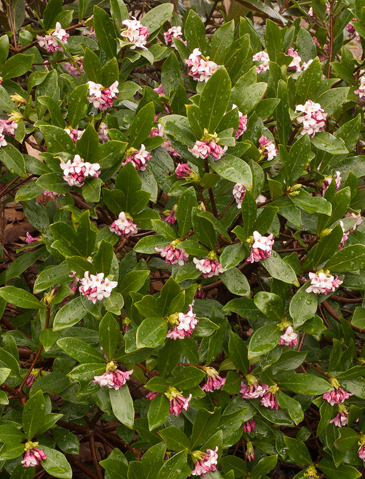Fragrance is elusive in the winter garden. But the blooms of winter daphne (Daphne odora) brave the chill of February to saturate the air with their sweet aroma, and reassure gardeners that yes, there will soon be another spring.
For all the positive mojo winter daphne brings into a chilled landscape, it is a modest plant. This small, rounded shrub only grows to about 4 feet high and wide. Its evergreen foliage is plentiful, yet plain, although the variegated cultivar ‘Aureomarginata’ is pleasantly swiped with streaks of butter-yellow.
Even the scented flowers are humble, being tight clusters of small, rose-pink or white stars.
But, oh, what a scent!
With such an unexpected, pleasant fragrance from its blooms during the coldest times, winter daphne should be the darling of gardeners searching for year-round interest in their landscapes.
But the popularity of this beauty has been tempered by its reputation of being a short-lived plant.
True, winter daphne doesn’t seem to be as stout as many other plants, but often times, its fleeting stay in the garden is the result of improper planting. The thick red clay that is common in our region is the usual culprit — toss a winter daphne into a hole of this gooey soil, and root or crown rot certainly could follow.
To extend the life of a winter daphne, plant it in an area that has excellent drainage. Putting it in a raised bed or on an elevated mound will definitely help, especially if the soil is heavily amended to loosen the red clay’s grip.
Tilling in plenty of compost or shredded leaves (run ‘em over with the lawn mower) will lighten the growing ground up, as will including a soil additive such as PermaTill, which is small, porous rocks that physically keep clay particles separated. And add a bit of lime to hold the soil’s pH close to neutral.
Winter daphne is also sensitive to drying out, so place it in an area that receives morning sun but is in at least semi-shade during the afternoon summer heat. Adding a 2- to 3-inch layer of mulch around the plant — keeping it a few inches away from the trunk — will also help even out its ground moisture supply.
Once your winter daphne is planted, do not disturb the roots! This means no digging close to the root zone and don’t even think about moving it!
An established winter daphne can live for many years. But whether one graces your garden for two, 10 or more years, its intoxicating perfume filling the air of deep winter certainly makes this special plant worthy of a try in your garden.
L.A. Jackson is the former editor of Carolina Gardener Magazine. Want to ask L.A. a question about your garden? Contact him by email at: lajackson1@gmail.com.
To Do in the Garden: February
- Cool-season grasses such as fescue and bluegrass should be given an application of nitrogen about the middle of this month at the rate of one pound per 1,000 square feet of lawn.
- Ornamental grasses such as pampas grass, liriope and mondo grass can be pruned now to get them ready for spring. In addition, overcrowded clumps can be divided and replanted.
- Lightly fertilizing fall-planted bulbs when shoots begin peeking out of the ground will improve their spring flower show.
- For flashier, longer bloom displays from pansies through the late winter and into spring, remove spent blooms regularly, and water the plants every three weeks with a weak fertilizer solution of one tablespoon of 8-8-8 or 10-10-10 per gallon of water.
- Time to crank up the veggie garden! Cool-season delectable edibles such as cabbage, onions, radishes, turnips and garden peas can be planted at the beginning of this month, while carrots, kale, lettuce, potatoes, mustard and spinach can go in the ground late in February.
- Make sure your motorized garden tools can rev up properly this spring by removing any gas that might be left over from last fall. Gasoline can lose its pop over time and gum up carburetors, leading to repair work at the wrong time of year.
- When watering indoor plants this winter, fill a container with tap water and allow it to warm to room temperature before irrigating cold-sensitive plants.
- Watch for spider mites, aphids and mealy bugs on house plants this winter. Warm, dry air inside houses encourages these pests to come out and play in a bad way!
- To prepare for spring nesting season, clean out bird houses and make any necessary repairs. Also, give the bird bath a good scrubbing and continue to add fresh water every week.
 Timely Tip
Timely Tip
Freezing February is actually a rosy month, meaning bare-root roses can be planted now. Whether you buy such roses online or at local garden shops, try to plant your beauties-to-be as soon as possible after receiving them.
However, the roots should be soaked in water for at least a few hours before planting. Dig the hole 12 to 18 inches deep, and wide enough to spread the roots out, usually about 2 feet in diameter.
Forming a dirt mound in the hole’s center will help stretch and support the roots while they are being firmed into the planting site. And remember, for the best performance, roses should be located in a spot that receives at least six hours of full sunlight.







